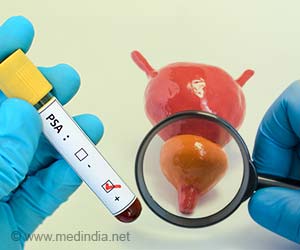
This is due to the current first-line blood test for prostate cancer that detects raised levels of the
. This test is not very reliable as well as it gives false positives. False positives include not just false alarms where there is
Advertisement
Lead author Prof. Sir Nicholas Wald (UCL Institute of Health Informatics) said: “A key drawback of screening for prostate cancer using a PSA test alone is the higher risk of a false positive, which can lead to an unnecessary, invasive biopsy and the unnecessary treatment of a clinically insignificant cancer that would not have caused harm anyway.
What is False Positive?
False positive result indicates a specific disease or condition in a person when none exists. Whereas at the opposite spectrum a false negative result indicates that a condition or disease that exists is shown as not existing or absent on testing.
Which is the Best Way to Screen for Prostate Cancer?
For the study, researchers looked at data and blood samples from more than 21,000 men recruited into the prospective study over 40 years ago.
They analyzed several prostate cancer markers in blood samples of 571 men who later died from or with prostate cancer, compared with a control group of 2,169 men who were never diagnosed with the disease.
They found that while hK2 was a relatively weak marker for prostate cancer on its own, it was relatively independent of PSA so the two together yielded a more accurate test (3✔ ✔Trusted Source
Multi-marker risk-based screening for
prostate cancer
Go to source).
They grouped the results of the total PSA and hK2 tests based on how far away from average they were present according to the participant’s age. This was done to include age in the risk assessment.
All men who were estimated to have a one in 20 or greater risk of developing prostate cancer in the next five years were counted as “screen positive”.
They also found that if men aged 55 and over were screened at least five-yearly using this risk cut-off, 90% of cancer cases would be detected, with only 1.2% of cases being false positives.
READ RELATED: Why fruit and veg could be nature's secret sleep remedy
If a PSA test had been used to screen for the disease on its own, and 86% detection rate would have been accompanied by a false positive rate of 2%.
By comparison, if the risk-based approach had been adjusted to have a detection rate of 86%, the false positive rate would have been 0.5% – a reduction of three quarters.
How to Improve Prostate Cancer Screening?
This study result shows that setting a risk range above which men are screened positive would reduce the number of false positives by three quarters compared to a standard PSA test while catching the same rate of cancers (3✔ ✔Trusted Source
Multi-marker risk-based screening for
prostate cancer
Go to source
).
This new approach is innovative for prostate cancer, as it screens people based on their overall risk rather than the results of a single test. This is the same approach used in screening during pregnancy for certain fetal and maternal health conditions.
Utilizing the levels of two prostate cancer markers, PSA and hK2 (human kallikrein peptidase) will refine prostate cancer screening. The use of PSA alone has significant drawbacks in terms of screening, but the addition of the hK2 marker carries the genuine promise of significantly reducing the death rate from this commonly diagnosed cancer in men (4✔ ✔Trusted Source
New risk algorithm would improve screening for prostate cancer
Go to source).
The next step is to test the feasibility of this approach in practice with a pilot study inviting healthy men for screening. If this project happens to be successful, this approach should be considered as part of a national screening program for all men.
References :
- Prostate Cancer: Statistics – (https://www.cancer.net/cancer-types/prostate-cancer/statistics)
- What Is Screening for Prostate Cancer? – (https://www.cdc.gov/cancer/prostate/basic_info/screening.htm)
- Multi-marker risk-based screening for prostate cancer – (https://journals.sagepub.com/doi/pdf/10.1177/09691413221076415)
- New risk algorithm would improve screening for prostate cancer – (https://www.ucl.ac.uk/news/2022/mar/new-risk-algorithm-would-improve-screening-prostate-cancer)
Source: Medindia
Source:







